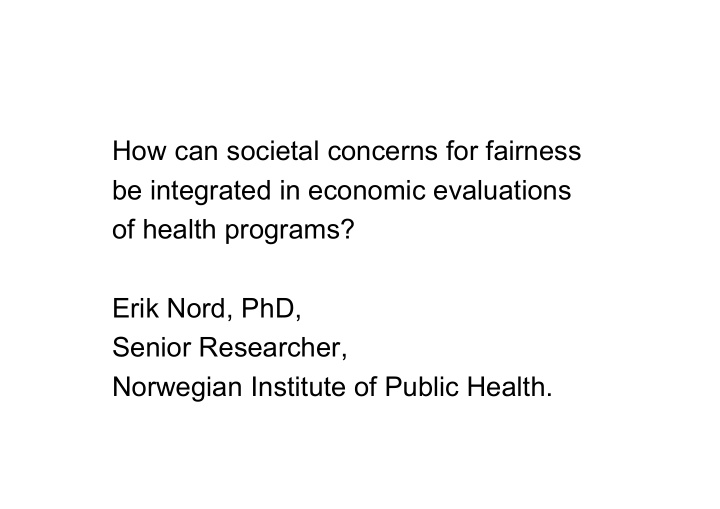



How can societal concerns for fairness be integrated in economic evaluations of health programs? Erik Nord, PhD, Senior Researcher, Norwegian Institute of Public Health.
Standard economic evaluation: Cost-utility analysis (CUA) based on the Quality Adjusted Life Year (QALY) Strongly recommended and used in the UK by NICE. Also: US, Canada, Australia. Alternative: Cost-value analysis (CVA)
QALYs illustrated Utility 1 0.8 B: 2 QALYs 0.6 A C: 6 QALYs 0 0 1 10 Years
Issue 1: Variation in utility estimates. Multi-attribute utility instruments . Example: EQ-5D (preferred and recommended by NICE) Dimensions: Mobility, self care, usual activities, pain, depression/anxiety Levels: 1: No problem; 2: some problems; 3: severe problems Examples from value table: A: 21211. ca. 0.8 B: 21222. ca. 0.6
Issue 1: Differences between multi-attribute utility instruments (E.g. Nord, Consi- Moderate C=>M IJTAHC derable problem 1996) problem EQ-5D 0.45 0.80 0.35 (UK tto) HUI 2 0.70 0.92 0.22 15-D 0.86 0.92 0.06
Fairness issues
Gained life years in people with illness Utility . H=1.0 B=0.7 Life threatened X Y Society’s valuation: V(Y) mostly equal to V(X) (Equal Value of Life) Sources: Intuition. Harris 1987. Oregon 1991; Murray 1996; Nord 1999; Johannesson 2002; Nord, Richardson & Menzel, 2003. Self interest: Ex post to illness: V(Y) mostly equal to V(X) Ex ante: Anticipation?
Fairness continued: Severity (concerns for the worse off ) X Y Theories of justice, government commissions: V(X) > V(Y)
Severity continued: Evidence in health economics Utility H=1.0 B=0.7 A=0.4 X Y Direct societal valuation: V(X) not = 2 V(Y) but = 3 -10 V(Y) Nord; Ubel et al; Dolan; Richardson; 1991-1998.
Fairness continued: Non-fatal disease: Realising a person’s potential Utility H=1.0 B=0.7 A=0.4 X Y Norwegian Government Commission 1987: X and Y equally entitled. Norman Daniels late eighties: ’Best outcomes/fair chances’. Health economics literature: V(Y) > ½ V(X) (Nord, Pinto, Dolan and Cookson 1991-1998)
Issue 4: Value as a function of the number of years gained
Societal views on duration Abel Olsen, Norway, 1994: 100 persons, 10 years gained = 80 persons, 20 years gained Dolan and Cookson, York Regional Health Authority, 1998: Little differentiation between 10 and 20 years gained.
Conclusion so far QALY calculations may give quite poor guidance for priority setting, due to: 1. Lacking concern for severity. 2. Too strong emphasis on capacity to benefit.
Example of poor guidance NICE, EQ-5D: P reventing 50 cases of ’some problems with walking and with usual activities, no other problems’ .. .. is as valuable as preventing 10 cases of fatal heart attack.
What to do? General rule: If important aspect, change formal model. If marginal aspect, take into account informally in decision making.
(1) Valuing gained life years in less than full health • Refrain from quality adjusting gained ’liveable’ life years. (Nord et al 1999, cfr also DALYs.)
(2) Valuing different quantities of gained life years More direct research needed on the value of duration. Possible modifications of the model: Increased discount rate. Disregard years above a certain number.
(3) Valuing gains in functioning/QoL: Transformation of utilities. (Nord, 1996, cfr. Nord, Richardson, Pinto et al, 1999.) Values for valuing change 1.0 B’ 0.95 A’ 0.8 Utilities from the viewpoint of healthy A:0.4 B:0.7 1.0
Example of transformation: EQ-5D EQ-5D Societal value for priority setting A (21222) 0.60 0.96 B (21211) 0.80 0.99 A=>B 0.20 0.03 B=>Healthy 0.20 0.01 A=>Healthy 0.40 0.04 (Nord E, Annals of Medicine 2001, 33, 371-374).
Hypothesis: Some convergence between individual utility and societal value.
The ’Utility Subtraction Method’ (USM) for valuing gains in QoL • Problem: V(B=>A) • Conventional procedure: (1) Measure ex ante utility of A and B (2) V(B=>A) = U(A) – U(B) Rationale: Feasibility: If n states, n/2(n-1) changes. Question: The validity of equation (2).
Intuition/plausibility: Will group A below necessarily be only half as interested in treatment as group B? If not, could this also show up in informed insurance preferences? States valued by community sample (mostly in normal health) Y X A B Groups in state X with potentials for full health and state Y respectively
Pilots at NIPH • N ~ 30 • Department of Mental Health • Mainly psychologists. Some doctors and other academics.
Theme 1: The strength of desire for treatment (ex post to illness) • 1 Healthy • 2 • 3 • 4 • 5 • 6 • 7 Bedridden
Opinions, theme 1: How many believed patients A would be much more (>>) or more (>) interested in treatment than patients B? A>>B A>B A=B N A: 7 => 2 B: 7 => 5 2 6 16 23 A: 6 => 2 B: 6 => 4 2 8 21 31 Anticipation in insurance decisions?
Insurance, life threatening illnesses (pilot at NIPH) Illness A: p = 10 %, 20 years to be gained from treatment. Illness B: p = 20 %, 7 years to be gained from treatment. Expected utility of insurance: A: 0.1 x 20 = 2 years B: 0.2 x 7 = 1,4 years Preferences: A: 12 B: 19 Implied discount rate: 8-9 %.
Conclusions If comparison of ’value for money’ in different areas of health care is of interest to decision makers: then QALYs may serve as a first step … .. provided there is no quality adjustment of desired, gained life years .. and in a next step, numbers from existing QALY tools are transformed to account for – concerns for the worse off; – wishes not to discriminate unduly against those with lesser potentials. Considerable data to support such cost-value analysis already exists. More research is welcome.
Recommend
More recommend